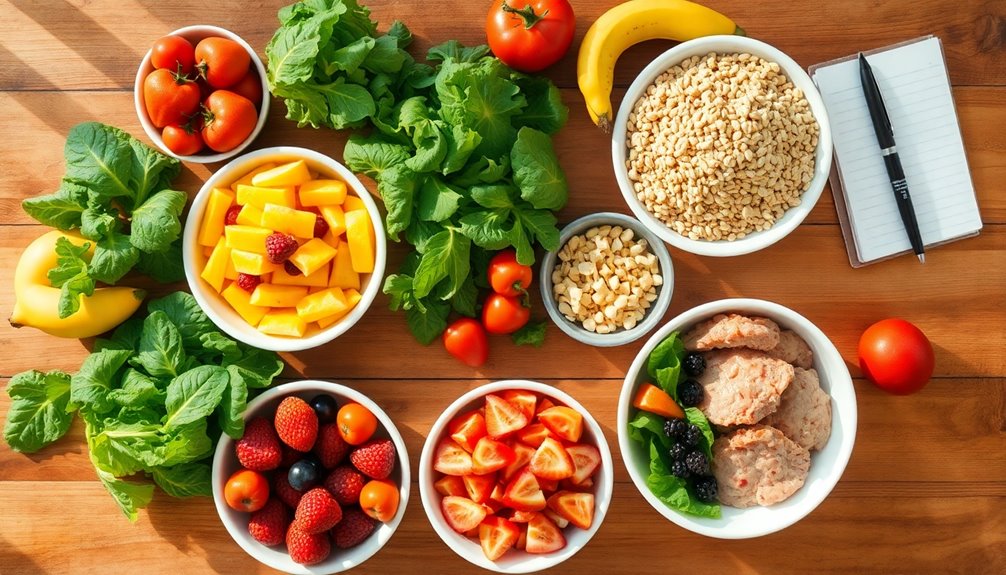To create your own 7-day balanced diet plan, begin by evaluating your nutritional requirements depending on your activity level and health objectives. Incorporate a range of food categories—protein, whole grains, fruits, and vegetables—in each meal. Outline particular meals and snacks to stay focused, and practice portion control by utilizing smaller plates and mindful eating strategies. Explore different tastes by incorporating herbs and spices, and don't hesitate to substitute ingredients for more nutritious choices. Track your progress and modify your plan as necessary to fit your preferences. There's plenty more to discover about constructing a long-lasting diet plan.
Key Takeaways
- Assess your caloric needs and adjust macronutrient ratios based on your health goals, such as muscle building or weight loss.
- Plan meals incorporating a variety of food groups to ensure balanced nutrition and include snacks for flexibility.
- Practice portion control by using smaller plates and being mindful of serving sizes to avoid overeating.
- Experiment with diverse flavors and ingredient swaps to keep meals interesting and nutritious while enhancing taste with herbs and spices.
- Monitor your progress through a food diary or app, and adjust your meal plan based on your preferences and how foods make you feel.
Assess Your Nutritional Needs

Before you start on creating a balanced diet plan, it's pivotal to evaluate your nutritional requirements. Begin by determining your caloric intake, which varies based on factors like age, sex, activity level, and overall health. You might find it helpful to use online calculators or consult a nutritionist to get a personalized estimate. Knowing your daily caloric needs will serve as a foundation for your diet plan, helping you to decide how many calories to consume each day.
Next, focus on macronutrient distribution. You'll want to understand the roles of carbohydrates, proteins, and fats and how they contribute to your overall health.
For example, a common recommendation is to allocate around 45-65% of your calories to carbohydrates, 10-35% to protein, and 20-35% to fats. Adjust these percentages based on your lifestyle and fitness goals.
If you're trying to build muscle, you might lean towards a higher protein intake, while someone aiming for weight loss might prioritize healthy fats and fiber-rich carbs. Additionally, incorporating a plant-based diet can provide significant health benefits, making it easier to meet your nutritional needs while enjoying a variety of delicious foods.
Understand Food Groups

Understanding food categories is essential to constructing a well-rounded diet that meets your nutritional requirements. Each food category provides unique advantages, guaranteeing you receive a variety of necessary nutrients. You'll typically encounter five primary food categories: fruits, vegetables, grains, proteins, and dairy. Including a diverse selection of these foods promotes overall health and wellness.
Fruits and vegetables are fundamental components, loaded with vitamins, minerals, and antioxidants. They not only bolster your immune system but also aid in maintaining a healthy weight.
Whole grains offer fiber, which assists in digestion and keeps you satiated for longer periods. Concerning proteins, lean meats, fish, legumes, and nuts are exceptional options that support the development and repair of tissues.
If you have dietary limitations, it's important to adjust your food category selections accordingly. For example, if you're intolerant to lactose, contemplate plant-based dairy alternatives like almond or soy milk. Similarly, if you adhere to a vegetarian or vegan diet, prioritize plant-based proteins such as lentils, chickpeas, and quinoa to make sure you're fulfilling your protein requirements.
Comprehending these food category advantages empowers you to make educated choices that align with your lifestyle. By acknowledging the offerings of each category, you'll feel enabled to prepare meals that not only nourish your body but also promote a sense of community inclusivity. Additionally, utilizing tools like progress tracking tools can enhance your commitment to a balanced diet plan and help monitor your nutritional goals.
Plan Your Meals

Planning your meals is an essential step in achieving a balanced diet that aligns with your health goals. By taking the time to map out your week, you can guarantee you're getting a variety of nutrients while also enjoying delicious foods. Start by dedicating a day to meal prep, which can save you time and reduce stress during the week. Set aside a few hours on the weekend to cook, portion, and store your meals.
To keep things interesting, brainstorm some recipe ideas that incorporate different food groups. Think about easy-to-make options like:
- Quinoa salad with mixed vegetables
- Baked chicken with sweet potatoes
- Vegetable stir-fry with tofu
These meals not only nourish your body but also satisfy your taste buds. Don't hesitate to experiment with flavors and ingredients that resonate with you; this is your journey!
Make a shopping list based on your meal plan to guarantee you have all necessary ingredients on hand. This helps you avoid impulse purchases and keeps your diet on track. When planning, consider prepping snacks too, like sliced fruits or veggie sticks with hummus, to keep you fueled throughout the day.
Lastly, remember to remain flexible. Life happens, and it's okay to adjust your plan as needed. The goal is to create a sustainable routine that supports your health while allowing you to enjoy your meals and feel a sense of community with those you share them with. A well-structured plan can even lead to improved overall health and help you stay motivated on your journey. Happy meal planning!
Portion Control Essentials

Portion control is an important aspect of maintaining a balanced diet and can greatly impact your overall health. When you understand what healthy serving sizes look like, you'll not only manage your weight better but also feel more energized and satisfied after meals. Start by familiarizing yourself with standard serving sizes for various food groups.
For instance, a serving of protein is typically the size of your palm, while a cup of vegetables should fill your fist.
Incorporating mindful eating practices can also enhance your portion control efforts. This means savoring each bite and paying attention to your body's hunger cues. When you eat slowly, you allow your brain the time it needs to register fullness. Try putting your fork down between bites and engaging in conversation during meals, which can help you become more aware of how much you're consuming.
Another practical tip is to use smaller plates and bowls. This simple change can trick your mind into thinking you're eating more than you actually are. It's a small adjustment that can make a significant difference in your portion sizes. Also, consider dividing your plate into sections to help balance your meals with the right proportions of proteins, carbohydrates, and healthy fats.
Additionally, being mindful of your portion sizes can support lifestyle changes that are essential for managing conditions like Chronic Kidney Disease (CKD).
Incorporate Variety and Flavor

Everyone benefits from a little variety in their meals, and adding different flavors can make healthy eating more enjoyable. By incorporating diverse flavor combinations, you can make each meal exciting and satisfying. For instance, try mixing sweet and spicy by adding a touch of honey to your chili. This not only tantalizes your taste buds but also makes it easier to stick to your balanced diet.
Don't hesitate to explore ingredient swaps to keep your meals fresh. If you love pasta, consider swapping regular noodles for zucchini or whole-grain options. These alternatives maintain the satisfaction of your favorite dishes while boosting their nutritional value.
Similarly, if you're fond of creamy sauces, try using Greek yogurt instead of heavy cream. You'll cut calories and add protein without sacrificing flavor. Furthermore, incorporating whole food sources of protein into your meals can enhance your nutritional intake and support your overall health.
Experimenting with herbs and spices can also elevate your meals. Fresh basil, cilantro, or a sprinkle of chili flakes can transform a simple dish into something extraordinary. Don't shy away from trying new cuisines either; Mediterranean, Asian, or Mexican foods offer a wealth of flavors that can inspire your meals.
Lastly, plan your meals with friends or family in mind. Sharing recipes and cooking together fosters a sense of belonging and encourages everyone to try new flavors. Remember, variety isn't just about different foods; it's about creating a joyful and nourishing experience that you can share with others. So, get creative and make your meals an adventure!
Monitor and Adjust Your Plan

Monitoring your progress is essential to guarantee your balanced diet plan works for you. To stay on track, start by tracking your progress regularly. This could be as simple as keeping a food diary or using an app to log your meals and snacks. Recording what you eat helps you identify patterns, recognize successes, and pinpoint areas needing adjustment.
Don't hesitate to seek guidance if you find yourself struggling. Whether it's a registered dietitian or a supportive friend, having someone to share your journey with can make a big difference. They can provide valuable insights and encouragement, helping you stay motivated and focused on your goals.
As you monitor your progress, pay attention to how you feel both physically and mentally. If you notice that certain foods energize you while others leave you sluggish, adjust your plan accordingly. Nutrition isn't one-size-fits-all, and personalizing your diet to meet your unique needs will enhance your experience. Remember, implementing age-old strategies can also help you achieve a lean and youthful body.
Remember, it's okay to tweak your plan as you go. If you're not enjoying your meals or feeling satisfied, consider changing up your recipes or incorporating new ingredients. The more aligned your diet is with your preferences, the easier it'll be to stick to.
Ultimately, your balanced diet plan should fit seamlessly into your life, fostering a sense of belonging to a healthier lifestyle. By actively monitoring and adjusting your approach, you'll make meaningful progress toward your wellness goals.
Frequently Asked Questions
Can I Include Snacks in My 7-Day Diet Plan?
Yes, you can absolutely include snacks in your 7-day diet plan! Healthy snacking can help curb hunger and keep your energy levels steady. Just focus on portion control to guarantee you're not overdoing it. Opt for nutrient-dense options like fruits, nuts, or yogurt.
How Do I Handle Food Cravings During the Week?
Handling food cravings during the week can be challenging, but you've got options. Start with craving management by identifying triggers and choosing healthy options that satisfy your cravings.
Practice mindful eating—slow down and savor each bite. If you indulge, focus on portion control to prevent overdoing it.
What to Do if I Miss a Meal?
Missing a meal can feel like dropping a ball in a juggling act. If it happens, don't panic! Focus on emergency options like healthy snacks or a quick smoothie to keep your energy up.
Then, implement recovery strategies by planning your next meal and adjusting portion sizes. Remember, it's about balance and being kind to yourself.
You're part of a community working towards health, and we all stumble sometimes. Just keep going!
Are There Specific Foods to Avoid Completely?
When considering foods to avoid completely, focus on minimizing sugar substitutes and processed foods. These often contain artificial ingredients that can disrupt your body's natural balance. Instead, prioritize whole, unprocessed options that nourish you and keep your energy stable.
How Can I Stay Motivated Throughout the Week?
Staying motivated throughout the week can feel like climbing a mountain, but you can reach the summit. Start by setting clear goals and tracking your progress daily; this'll help you see how far you've come.
Find support in friends or groups who share your journey, and don't forget to reward yourself for milestones. Each small victory builds a sense of belonging, making the climb not just easier, but also more enjoyable.
Conclusion
Creating your own 7-day balanced diet plan can greatly enhance your overall health. Studies show that individuals who plan their meals are 50% more likely to stick to healthier eating habits. By evaluating your nutritional needs, understanding food groups, and incorporating variety, you're setting yourself up for success. Remember, it's all about balance and personalization. Don't hesitate to adjust your plan as you go; it should evolve to fit your lifestyle and preferences.



